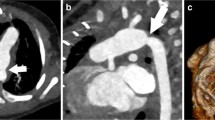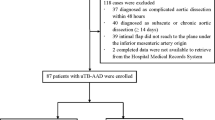Abstract
Objective
To determine whether resting pre-operative left ventricular ejection fraction (LVEF) estimated by multiple gated acquisition scanning (MUGA) predicts long-term survival in patients undergoing elective abdominal aortic aneurysm (AAA) repair.
Methods
A retrospective study of MUGA scans which were performed to estimate pre-operative resting LVEF in 127 patients [106 (83 %) males, mean age 74 ± 7.6 years] who underwent elective AAA repair over a period of 4 years from March 2007. We compared outcomes and long-term survival between patients who had a pre-operative LVEF ≤ 40 % (Group 1, n = 60) and LVEF > 40 % (Group 2, n = 67).
Results
Overall 19 (15 %) patients died during the follow-up period (13 patients in group 1 and 6 patients in group 2). 30-day mortality was 8 %. There was no significant difference between group 1 and 2 in terms of patients’ mean age or median length of hospital stay (8 days for both groups, p = 0.61). However, group 2 had more females than group 1(18 vs. 3, p = 0.001). Median survival for patients in group 2 was significantly higher than patients in group 1 (1,258 days vs. 1,000 days, p = 0.03). In a Cox regression model which included age, sex, smoking status and LVEF as covariates, only smoking status and LVEF predicted survival [Hazard ratio (HR) = 1.06, p = 0.04 and HR = 0.93, p = 0.00, respectively].
Conclusion
This study shows that there is a role for pre-operative MUGA scan assessment of resting LVEF in predicting long-term survival post elective AAA repair and that the lower the pre-operative LVEF the poorer the long-term outcome.

Similar content being viewed by others
References
Auerbach A, Goldman L (2006) Assessing and reducing the cardiac risk of non cardiac surgery. Circulation 48(964):969
Crawford ES, Saleh SA, Babb JW et al (1981) Infrarenal abdominal aortic aneurysm: factors influencing survival after operation performed over a 25-year period. Ann Surg 193(6):699–709
L’Italien GJ, Cambria RP, Cutler BS et al (1995) Comparative early and late cardiac morbidity among patients requiring different vascular surgery procedures. J Vasc Surg 21(935):944
Lloyd WE, Paty PS, Darling RC 3rd et al (1996) Results of 1,000 consecutive elective abdominal aortic aneurysm repairs. Cardiovasc Surg 4:724–726
Fleischer LA, Eagle KA, Shaffer T, Anderson GF (1999) Perioperative and long-term mortality rates after major vascular surgery: the relationship to preoperative testing in the Medicare population. Anesth Analg 89(849):55
Faggiano P, Bonardelli S, De Feo S et al (2012) Preoperative cardiac evaluation and perioperative cardiac therapy in patients undergoing open surgery for abdominal aortic aneurysms: effects on cardiovascular outcome. Ann Vasc Surg 26:156–165
Wong T, Detsky AS (1992) Preoperative cardiac risk assessment for patients having peripheral vascular surgery. Ann Intern Med 116:743–753
Brown LC, Powell JT, Thompson SG et al (2012) The UK EndoVascular Aneurysm Repair (EVAR) trials: randomised trials of EVAR versus standard therapy. Health Technol Assess 16(9):1–218
Curtis JP, Sokol SI, Wang Y et al (2003) The association of left ventricular ejection fraction, mortality, and cause of death in stable outpatients with heart failure. J Am Coll Cardiol 42:736–742
Mattleman SJ, Hakki AH, Iskandrian AS et al (1983) Reliability of bedside evaluation in determining left ventricular function: correlation with left ventricular ejection fraction determined by radionuclide ventriculography. J Am Coll Cardiol 1(2):417–420
Godkar D, Bachu K, Dave B et al (2007) Comparison and co-relation of invasive and noninvasive methods of ejection fraction measurement. J Natl Med Assoc 99:1227–1234
Karkos CD, Baguenid MS, Triposkiadis F et al (2004) Routine measurement of radioisotope left ventricular ejection fraction prior to vascular surgery: is it worthwhile? Eur J Vasc Endovasc Surg 27:227–238
Karkos CD, Thompson GJL, Hughes R et al (2002) Prediction of cardiac risk before abdominal aortic reconstruction: comparison of a revised Golldman cardiac risk index and radioisotope ejection fraction. J Vasc Surg 35:943–949
Kazmers A, Cerqueira MD, Zieler ER (1988) The role of preoperative radionuclide left ventricular ejection fraction in direct abdominal aortic aneurysm repair. J Vasc Surg 10:128–136
Kazmers A, Moneta GL, Cerqieura MD et al (1990) The role of preoperative radionuclide ventriculography in defining outcome after revascularization of the extremity. Surg Gynecol Obstet 171:481–488
Winkel TA, Schouten O, van Kuijk JP et al (2009) Perioperative asymptomatic cardiac damage after endovascular abdominal aneurysm repair is associated with poor long-term outcome. J Vasc Surg 50:749–754
Cohn PF, Gorlin R, Cohn LH et al (1974) Left ventricular ejection fraction as a prognostic guide in surgical treatment of coronary and valvular heart disease. Am J Cardiol 34(2):136–141
Hammermeister KE, Kennedy JW (1974) Predictors of surgical mortality in patients undergoing direct myocardial revascularization. Circulation. 50(2 Suppl):II112–5
Flischer LA, Beckman JA, Brown KA et al (2007) ACC/AHA 2007 guidelines on perioperative cardiovascular evaluation and care for noncardiac surgery: executive summary: a report of the American College of Cardiology/American Heart Association Task Force on Practice Guidelines (Writing Committee to Revise the 2002 Guidelines on Perioperative Cardiovascular Evaluation for Noncardiac Surgery). Circulation 116:1971–1996
Kertai MD, Boersma E, Bax JJ et al (2003) A meta-analysis comparing the prognostic accuracy of six diagnostic tests for predicting perioperative cardiac risk in patients undergoing major vascular surgery. Heart 89(11):1327–1334
Karkos CD, Thomson GJ, Hughes R et al (2003) Prediction of cardiac risk prior to elective abdominal aortic surgery: role of multiple gated acquisition scan. World J Surg 27:1085–1092. doi:10.1007/s00268-003-6970-3
Samy AK, Murray G, MacBain G (1996) Prospective evaluation of the Glasgow Aneurysm Score. J R Coll Surg Edinb 41(2):105–107
Bohm N, Wales L, Dunckley M et al (2008) Objective risk-scoring systems for repair of abdominal aortic aneurysms: applicability in endovascular repair? Eur J Vasc Endovasc Surg 36(2):172–177
Patterson BO, Karthikesalingam A, Hinchliffe RJ et al (2011) The Glasgow Aneurysm Score does not predict mortality after open abdominal aortic aneurysm in the era of endovascular aneurysm repair. J Vasc Surg 54:353–357
Bertges DJ, Goodney PP, Zhao Y et al (2010) The Vascular Study Group of New England Cardiac Risk Index (VSG-CRI) predicts cardiac complications more accurately than the Revised Cardiac Index in vascular surgery patients. J Vasc Surg 52:674–683
Giles KA, Schermenhorn ML, O’Malley J et al (2009) Risk prediction for perioperative mortality of endovascular vs open repair of abdominal aorticaneurysms using the Medicare population. J Vasc Surg 50:256–262
Egorova N, Giacovelli JK, Gelijns A et al (2009) Defining high-risk patients for endovascular aneurysm repair. J Vasc Surg 50:1271–1279
Wisniowski B, Barnes M, Jenkins J et al (2011) Predictors of outcome after elective endovascular abdominal aortic aneurysm repair and external validation of a risk prediction model. J Vasc Surg 54:644–653
Gottsauner-Wolf M, Schedlmayer-Duit J, Porenta G et al (1996) Assessment of left ventricular function: comparison between radionuclide angiography and semiquantitative two-dimensional echocardiographic analysis. Eur J Nucl Med 23:1613–1618
Van Royen N, Jaffe CC, Krumhoz HM et al (1996) Comparison and reproducibility of visual echocardiographic and quantitative radionuclide left ventricular ejection fractions. Am J Cardiol 77:843–850
Naik MM, Diamond GA, Pai T et al (1995) Correspondence of left ventricular ejection fraction determinations from two-dimensional echocardiography, radionuclide angiography and contrast cineangiography. J Am Coll Cardiol 25:937–947
Michaels JA, Payne SPK, Galland RB et al (1996) A survey of methods used for cardiac risk assessment prior to major vascular surgery. Eur J Vasc Endovasc Surg 11:221–224
Pullman MD, Edwards ND (1997) Current practice in the preoperative assessment of patients for elective repair of abdominal aortic aneurysm. Anaesthesia 52:367–373
Acknowledgments
None.
Author information
Authors and Affiliations
Corresponding author
Rights and permissions
About this article
Cite this article
Barakat, H.M., Shahin, Y., Khan, J.A. et al. Role of Pre-operative Multiple Gated Acquisition Scanning in Predicting Long-Term Outcome in Patients Undergoing Elective Abdominal Aortic Aneurysm Repair. World J Surg 37, 1169–1173 (2013). https://doi.org/10.1007/s00268-013-1939-3
Published:
Issue Date:
DOI: https://doi.org/10.1007/s00268-013-1939-3




